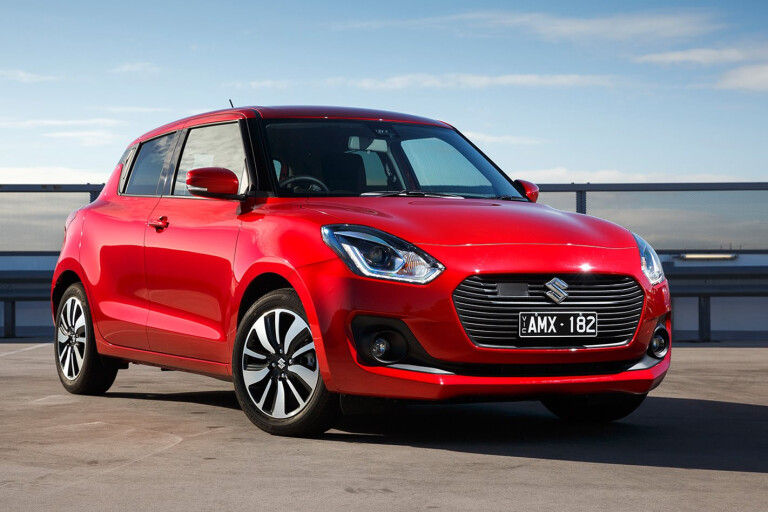Reviews

Gallery5
Suzuki’s third-generation Swift is here, with new engines, a new platform and plenty of new technology taking the humble Japanese hatchback from the back of the pack right to the pointy end.

5
STRENGTHS
- Thanks to an all-new platform, there’s more interior space than before. The new Swift measures 10mm shorter than its predecessor, but a longer wheelbase and greater overall width means there’s now more space for back seat passengers and more air between the front occupants. The boot also grows to a useful 242 litres, 32 litres bigger than the old Swift’s miniscule load area.
- The new Swift is incredibly light – just 915kg empty in its heaviest configuration – yet thanks to the use of more high strength steel in its construction it’s actually stronger and more rigid than before. That not only aids crash performance and handling, it also helps improve refinement as well.
- And speaking of refinement, the Swift’s smart new cabin furnishings give it a more sophisticated aura than before.

5
- The 66kW/120Nm 1.2 litre naturally-aspirated inline four that will motivate most Swifts sold in this country may have 4kW less power, 10Nm less torque and 200cc less displacement than the engine it replaces, but it’s a perky, rev-happy engine that works well when paired with the available five-speed manual or CVT automatic. The new Swift’s 100kg lighter kerb weight helps offset the new engine’s lower outputs.
- But if that’s not enough, then the Swift’s lively turbo 1.0 litre should supply the grunt you’re looking for. With 82kW and 160Nm on offer, this engine is the first turbo powerplant for Australian-market Swifts and one that boasts plenty of mid-range oomph. It comes standard with a six-speed automatic, and while we lament the unavailability of a manual, the automatic does a good job.
- The Swift handles like a larger car, with the darty, sensitive front axle of the outgoing model banished in favour of a more progressive and stable-feeling suspension. There’s some rack-rattle on rough-surfaced corners, but that’s about the only dynamic blot on the Swift’s report card.

5
- The GLX Turbo has plenty of equipment as standard, including high-end features like LED headlamps with auto highbeam, active cruise control, climate control plus keyless entry/ignition. That’s in addition to the autonomous emergency braking, satellite navigation, lane departure warning, reversing camera and 16-inch alloy wheels that are standard on lower grades.
- Sharp drive-away pricing sees the GL Navigator and GLX Turbo wear drive-away prices that are identical to their retail pricing. Confusingly, the base GL manual has a $1000 gap between its $15,990 retail and $16,990 drive-away price – it’s almost like Suzuki wants to discourage prospective buyers from buying the GL manual, given the step up to the $17,990 drive-away GL Navigator auto is a mere $1000.
- Fuel economy is good, with the manual Swift GL consuming 4.6L/100km on average and the CVT adding 0.2L/100km to that number. The Swift GLX Turbo, as the heaviest car in the range and the sole turbocharged one, records a factory claim of 5.1L/100km.
WEAKNESSES
- Base model misses out on key equipment like smartphone mirroring, a touchscreen infotainment display and a reversing camera. That’s a shame, because it’s the only model to come with the enjoyable five-speed manual – there’s no way to have your Swift with three pedals and an integrated sat-nav screen at the same time.
- You’ll need to pay more for Autonomous Emergency Braking (AEB) as well. While that technology is fast becoming standard on many small cars, you’ll need to pony up to the Swift GLX Navigator with Safety Pack or the Swift GLX Turbo.
- No variant has parking sensors as standard – even the $23k Swift GLX. The base GL manual is doubly-penalised by not having a reversing camera either.

5
- Only the GLX Turbo has a steering column that adjusts for reach as well as tilt. Why? We don’t know. The GL grades only get a tilt-adjustable column.
- Over the shoulder vision is hampered by the Swift’s fat C-pillar. You can partly blame its stylish-but-functionally-nonsensical vertical rear door handle for that one.
- The 1.0 litre turbo three-cylinder, arguably the sweetest engine in the family, is not available with a manual transmission. The six-speed auto it’s paired with by default does an appreciably good job, but a manual would allow drivers to enjoy that lovely triple-cylinder engine to its fullest.
- Similarly, we’re annoyed the Swift’s delightful 1.0 litre turbo is confined to the top-shelf GLX grade only, meaning fewer buyers will get to call that engine their own.
ANYTHING ELSE I SHOULD CONSIDER
Absolutely. There’s plenty of healthy competition in the light hatch segment, with cars like the Mazda2, Honda Jazz, Volkswagen Polo and Toyota Yaris all boasting significant merits. The Swift, may not be able to compare with most on metrics like power or torque, but its substantially lighter construction means it drives just as well while also delivering good fuel economy.
COMMENTS